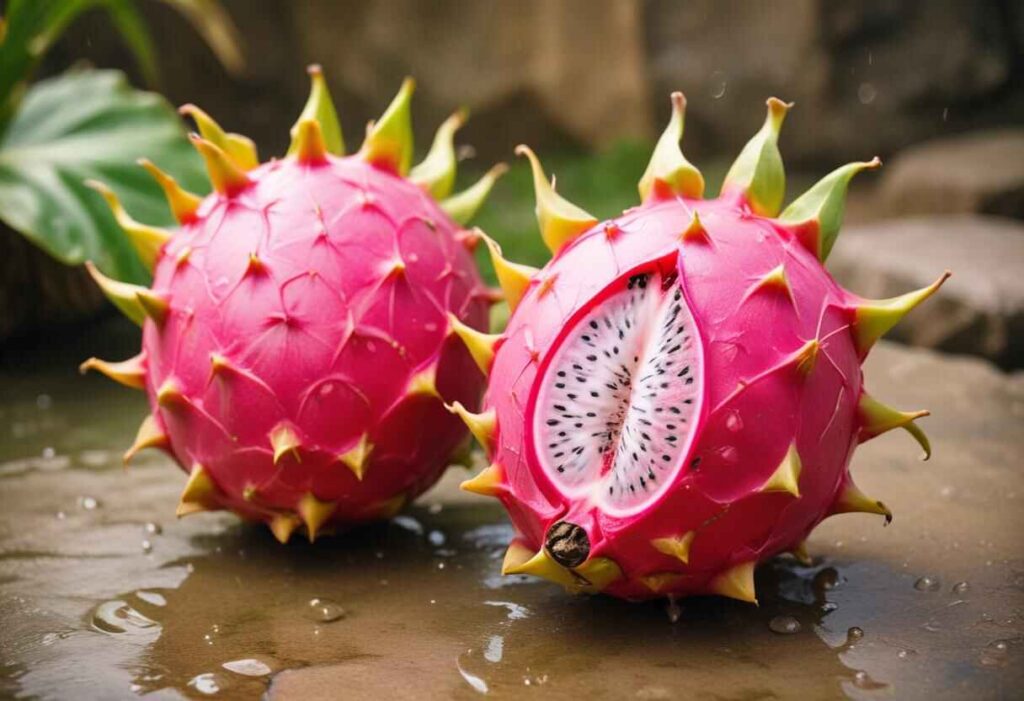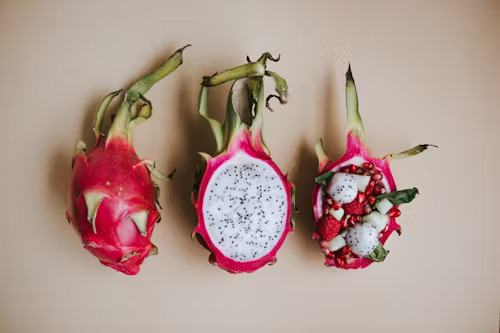Have you ever seen a fruit that looks like it came from a magical place? Dragon fruit definitely does! It’s got bright colors and surprises inside, just like a treasure chest. But there’s more to it than just looks. Let’s find out what makes this fruit taste so special! Get ready for a yummy adventure into the world of dragon fruit flavor!
A Hint of Sweetness with a Little Kick
Let’s start with this: dragon fruit is mildly sweet, not too strong. It’s like a gentle nudge to taste more, not like those really sweet tropical fruits. This mild sweetness lets other flavors come through, making a yummy mix in your mouth.
What Does Dragon Fruit Taste Like?
Dragon fruit tastes a bit sweet, like a mix of pear and kiwi. Its texture is soft and a bit crunchy, like a ripe kiwi. Here’s a quick look:
- Sweetness: Kind of sweet
- Flavor: Like pear and kiwi, with some saying it also has a hint of flowers or berries.
- Texture: Soft and a bit crunchy, like a kiwi.
Remember, the taste can change depending on the type and how ripe the fruit is. The ripest ones will be the sweetest and tastiest, while ones that aren’t ripe yet might not have much flavor.

A Common Taste: Pear and Kiwi
People often say dragon fruit tastes like a mix of pear and kiwi. Think about the sweet juice of a pear mixed with the tangy freshness of a kiwi. That’s what makes up the main flavor of dragon fruit, giving it a familiar but fun taste.
Different Types of Dragon Fruit
Dragon fruit usually tastes sweet and tangy with a creamy feel, but there are slight differences based on the type. Here are the main ones:
- Red Dragon Fruit: This is what most people think of when they hear “dragon fruit.” It can have white to deep red flesh and is generally the sweetest. Some say it even tastes a bit like watermelon.
- Yellow Dragon Fruit: This one has a sunny yellow outside and white inside. It’s not as sweet as the red kind and has a hint of citrus flavor.
- Pink Dragon Fruit: This type has bright pink skin and white flesh. It’s not as common, but it’s a mix of sweet and tangy, falling between the red and yellow varieties.

Using Dragon Fruit in Cooking and Recipes
Dragon fruit isn’t just tasty by itself. It can also be used in cooking in different ways:
- Salads: Chopped dragon fruit adds color, sweetness, and a nice crunch to salads.
- Smoothies: Its gentle sweetness and smooth texture make it great for smoothies. It mixes well with other fruits and veggies.
- Sorbet and Ice Cream: Make your own dragon fruit sorbet or ice cream for a cool, summery treat. It’s colorful and refreshing.
- Cocktails: Feeling bold? Crush some dragon fruit with your favorite drinks to make a special, colorful cocktail.
- Salsa and Dips: Chopped dragon fruit can add a surprising sweetness and texture to salsas and dips.
| Category | Details | Sub-Details |
| Types of Dragon Fruit | Three main varieties | – White-fleshed (Hylocereus undatus): Pink skin with white flesh and tiny black seeds. Mild, slightly sweet flavor. |
| – Red-fleshed (Hylocereus costaricensis): Red or pink skin with vibrant red flesh. Richer flavor, slightly tangy. | ||
| – Yellow-skinned (Hylocereus megalanthus): Yellow skin with white flesh. Sweeter and juicier than the other varieties. | ||
| Culinary Uses | Versatile in both sweet and savory dishes | – Salads: Adds a pop of color and a subtle sweetness to fruit or green salads. |
| – Smoothies and Bowls: Blends well with other fruits like mango, banana, and berries for vibrant smoothie bowls. | ||
| – Salsas: Combines with ingredients like lime, cilantro, and jalapeño for a refreshing salsa to accompany fish or chicken. | ||
| – Desserts: Used in sorbets, popsicles, and cakes for natural color and tropical flavor. | ||
| – Drinks: Used in cocktails, mocktails, and infused waters. | ||
| Nutritional Benefits | Low-calorie, nutrient-dense fruit | – Vitamins: High in Vitamin C, providing immune support and antioxidant benefits. |
| – Fiber: Rich in dietary fiber, promoting digestive health. | ||
| – Antioxidants: Contains betalains, flavonoids, and phenolic acid, which help combat oxidative stress and inflammation. | ||
| – Prebiotics: Supports gut health by promoting the growth of beneficial bacteria. | ||
| Popular Recipes | Simple to incorporate into everyday meals | – Dragon Fruit Smoothie: Blend dragon fruit with banana, yogurt, and honey for a vibrant and nutritious smoothie. |
| – Dragon Fruit Salad: Toss with mixed greens, avocado, cucumber, and a citrus vinaigrette for a refreshing salad. | ||
| – Dragon Fruit Sorbet: Puree dragon fruit with lime juice and a touch of sugar, then stop for a light and refreshing dessert. | ||
| – Dragon Fruit Salsa: Combine diced dragon fruit with red onion, cilantro, jalapeño, and lime juice for a sweet and spicy salsa. |
How Do You Eat Dragon Fruit?
Eating dragon fruit is simple and enjoyable because of its unique texture and mild sweetness. Here’s a quick recipe for eating it:
- Choose a Ripe Dragon Fruit: Look for one that’s vibrant and evenly colored, whether it’s red, yellow, or pink. The skin should be slightly soft but not too mushy when you press it gently.
- Wash It: Give the dragon fruit a rinse under cool running water to remove any dirt or residues.
- Cut It: Place the fruit on a cutting board and cut it in half lengthwise with a sharp knife. If you prefer smaller pieces, you can then cut the halves into quarters.
- Scoop Out the Flesh: Hold one half in your hand and use a spoon to scoop out the flesh. It should come out easily, like scooping out an avocado or kiwi. Alternatively, you can peel the skin off with your fingers, as it separates easily from the flesh.
- Get It Ready to Eat: If you like, you can dice the flesh into cubes or slices. Or, you can simply eat it straight from the skin with a spoon.
- Enjoy It: Dragon fruit is good enjoyed fresh and raw to savor its delicate flavor. You can also add it to fruit salads, smoothies, yogurt, or use it as a topping for desserts. Additionally, you can juice or blend it into drinks for a refreshing beverage.
Conclusion
Dragon fruit might look a bit strange, but it’s actually really tasty. It’s sweet and a little tangy, with a creamy texture and pretty color. It’s a fruit worth trying in your cooking. So, if you spot one at the store, go ahead and give it a try!

